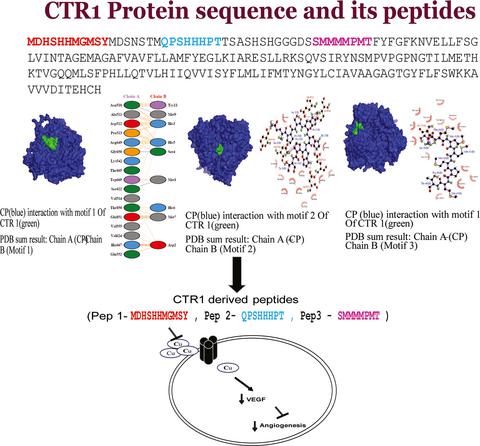当前位置:
X-MOL 学术
›
Chem. Bio. Drug Des.
›
论文详情
Our official English website, www.x-mol.net, welcomes your
feedback! (Note: you will need to create a separate account there.)
Peptides derived from histidine and methionine‐rich regions of copper transporter 1 exhibit anti‐angiogenic property by chelating extracellular Cu
Chemical Biology & Drug Design ( IF 3.2 ) Pub Date : 2017-12-06 , DOI: 10.1111/cbdd.13145 Iyer Gomathy Narayanan 1, 2 , Sulochana K. Natarajan 1
Chemical Biology & Drug Design ( IF 3.2 ) Pub Date : 2017-12-06 , DOI: 10.1111/cbdd.13145 Iyer Gomathy Narayanan 1, 2 , Sulochana K. Natarajan 1
Affiliation

|
Angiogenesis is a process of synthesis of new blood vessels from preexisting vasculature. Copper (Cu) as a micronutrient is important to many proteins for their physiological roles. Cu is transported by ceruloplasmin from liver to other parts of the body. Copper transporter 1 (CTR1) is a transmembrane protein which participate in Cu transport across the cell. It is also known to be involved in angiogenesis. In this study, we have designed three peptides from copper‐binding regions of CTR1 which are rich in histidine and methionine. These peptides were screened for their inhibitory effect on angiogenesis in the HUVEC model. Mass spectroscopy studies revealed that all the three peptides derived from CTR 1 (Pep 1, 2, and 3) bound to Cu. The intracellular Cu levels estimated by atomic absorption spectroscopy showed decreased levels of copper in peptide‐treated cells as compared to control. These peptides inhibited proliferation, migration, and tube formation in HUVEC by sequestering copper, preventing its entry into the cell and thereby inhibiting angiogenesis.
中文翻译:

铜转运蛋白1的富含组氨酸和蛋氨酸的区域衍生的肽通过螯合细胞外铜表现出抗血管生成特性
血管生成是从预先存在的脉管系统合成新血管的过程。铜(Cu)作为一种微量营养素,对于许多蛋白质而言,由于它们的生理作用而非常重要。铜通过铜蓝蛋白从肝脏转运到身体的其他部位。铜转运蛋白1(CTR1)是跨膜蛋白,参与跨细胞的铜转运。还已知其参与血管生成。在这项研究中,我们从CTR1的铜结合区域设计了三种富含组氨酸和蛋氨酸的肽。在HUVEC模型中筛选了这些肽对血管生成的抑制作用。质谱研究表明,源自CTR 1的所有三种肽(Pep 1、2和3)均与Cu结合。与对照相比,通过原子吸收光谱法估计的细胞内铜水平显示,肽处理细胞中的铜水平降低。这些肽通过隔离铜来抑制HUVEC中的增殖,迁移和管形成,从而阻止其进入细胞并从而抑制血管生成。
更新日期:2017-12-06
中文翻译:

铜转运蛋白1的富含组氨酸和蛋氨酸的区域衍生的肽通过螯合细胞外铜表现出抗血管生成特性
血管生成是从预先存在的脉管系统合成新血管的过程。铜(Cu)作为一种微量营养素,对于许多蛋白质而言,由于它们的生理作用而非常重要。铜通过铜蓝蛋白从肝脏转运到身体的其他部位。铜转运蛋白1(CTR1)是跨膜蛋白,参与跨细胞的铜转运。还已知其参与血管生成。在这项研究中,我们从CTR1的铜结合区域设计了三种富含组氨酸和蛋氨酸的肽。在HUVEC模型中筛选了这些肽对血管生成的抑制作用。质谱研究表明,源自CTR 1的所有三种肽(Pep 1、2和3)均与Cu结合。与对照相比,通过原子吸收光谱法估计的细胞内铜水平显示,肽处理细胞中的铜水平降低。这些肽通过隔离铜来抑制HUVEC中的增殖,迁移和管形成,从而阻止其进入细胞并从而抑制血管生成。











































 京公网安备 11010802027423号
京公网安备 11010802027423号